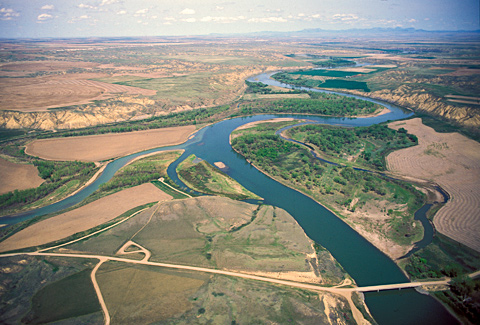In the late afternoon of Sunday, 2 June 1805, the Corps of Discovery “came too on the Lard. [larboard; their left] side in a handsome bottom of small cottonwood timber opposite to the entrance of a very considerable river.” Early the next morning they “passed over and formed a camp on the point formed by the junction of the two large rivers.” They now faced a crucial question: Which river was the Missouri?
Lewis admitted that the deeper waters of the north fork (entering from left in this photo) “run in the same boiling and roling manner which has uniformly characterized the Missouri throughout it’s whole course so far; its waters are of a whitish brown colour very thick and terbid, also characteristic of the Missouri.” Nevertheless, he was unconvinced that it was the true Missouri. The rest of the party, however, “with very few exceptions,” agreed with their chief waterman, Pierre Cruzatte: the north fork was the one to follow.
The captains noted that the south fork was clearer, smoother, and more rapid, and its bottom was “composed of round and flat smooth stones like most rivers issueing from a mountainous country.” They needed to reach the Rocky Mountains, where they hoped to find Sacagawea‘s tribe and get horses from them, and the south fork seemed more likely to lead them there. Nevertheless, just to be sure, they decided to spend a few days reconnoitering both forks. Meanwhile, Lewis named the north fork for his cousin, Maria Wood.
Today, the situation that vexed the Corps of Discovery is hard to appreciate. Tiber Dam, built eighty miles upstream in 1970, has restrained, calmed, and cleared “Maria’s River,” leaving part of its history etched in the broad floodplain at its mouth. Nevertheless, the true course of the Missouri can be confounding even from the air. The photographer flew up the north fork twenty miles before realizing it was the Marias.
See also on this site, Decision Point.
From Discovering Lewis & Clark from the Air
Photography by Jim Wark
Text by Joseph Mussulman
Reproduced by permission of Mountain Press
Experience the Lewis and Clark Trail
The Lewis and Clark Trail Experience—our sister site at lewisandclark.travel—connects the world to people and places on the Lewis and Clark Trail.
Discover More
- The Lewis and Clark Expedition: Day by Day by Gary E. Moulton (University of Nebraska Press, 2018). The story in prose, 14 May 1804–23 September 1806.
- The Lewis and Clark Journals: An American Epic of Discovery (abridged) by Gary E. Moulton (University of Nebraska Press, 2003). Selected journal excerpts, 14 May 1804–23 September 1806.
- The Lewis and Clark Journals. by Gary E. Moulton (University of Nebraska Press, 1983–2001). The complete story in 13 volumes.


